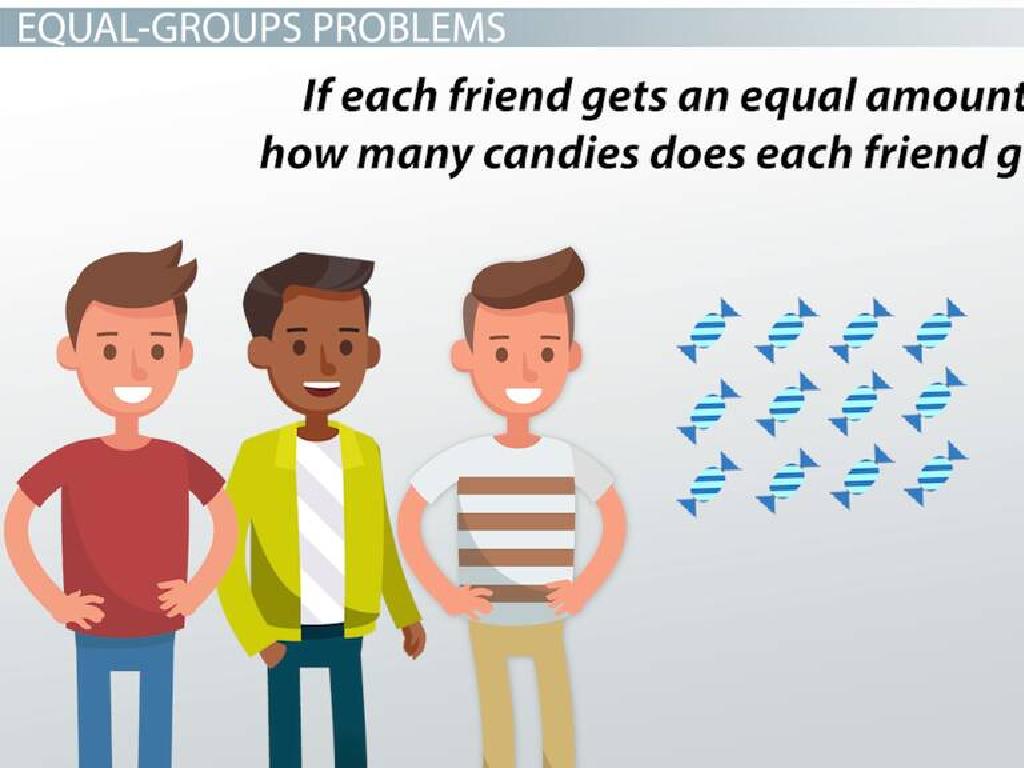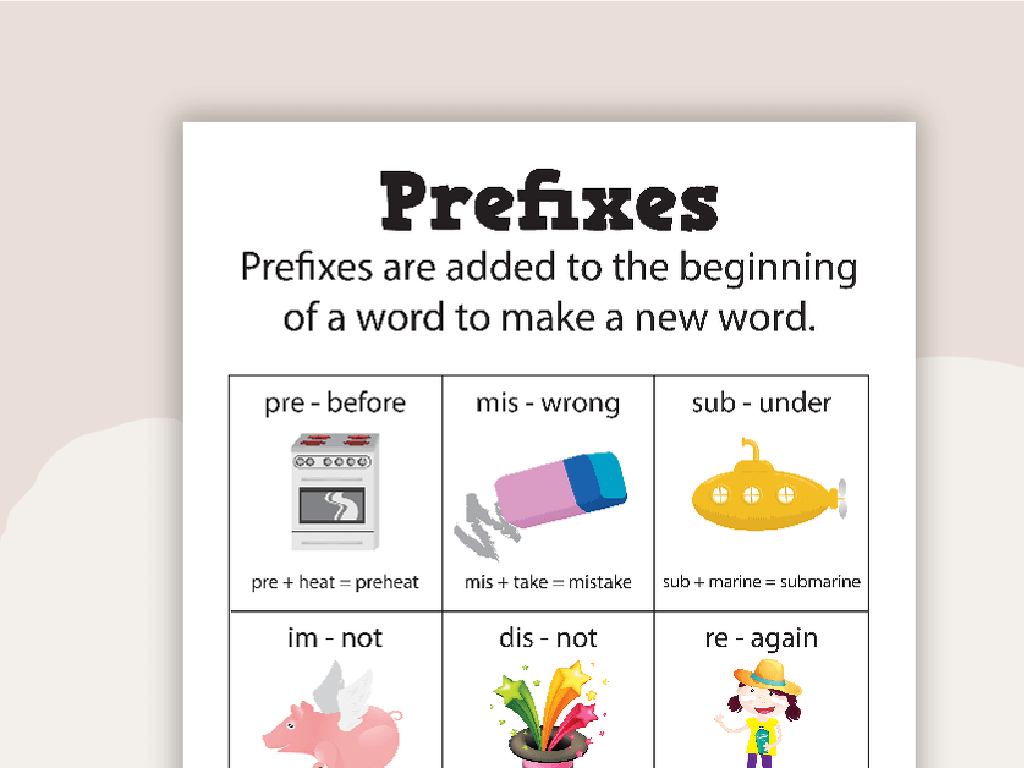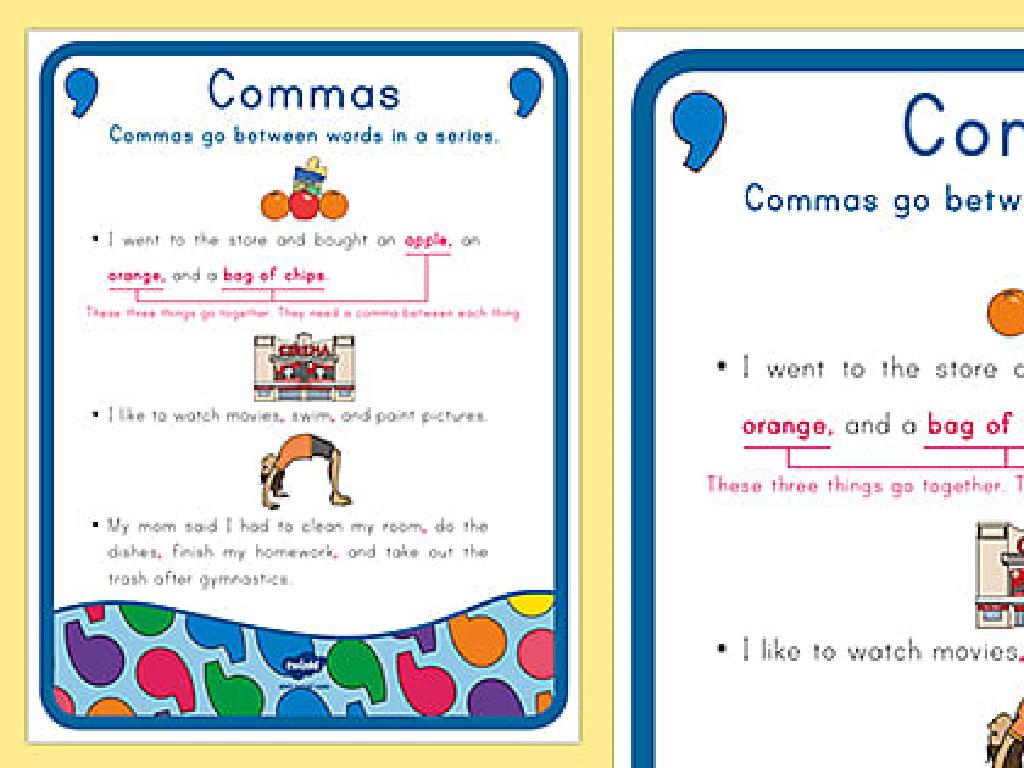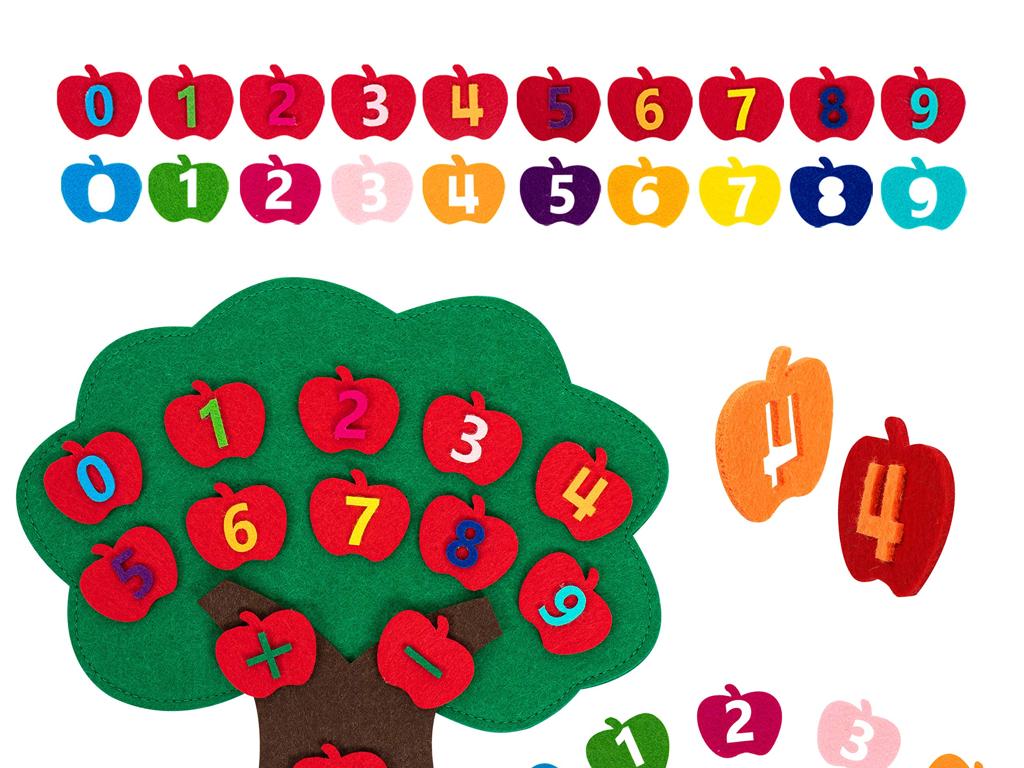Compound Subjects And Objects With "I" And "Me"
Subject: Language arts
Grade: Sixth grade
Topic: Pronoun Types
Please LOG IN to download the presentation. Access is available to registered users only.
View More Content
Compound Subjects and Objects with ‘I’ and ‘Me’
– Pronouns in sentence structure
– Pronouns take the place of nouns
– Correct use of ‘I’ and ‘me’
– ‘I’ is used as a subject, ‘me’ as an object
– Examples of ‘I’ and ‘me’ in sentences
– ‘I’ with subjects: I and my friends. ‘Me’ with objects: between you and me
– Importance of accurate pronoun use
– Using ‘I’ and ‘me’ correctly makes our sentences clear and grammatically correct
|
This slide introduces the concept of pronouns, focusing on the correct usage of ‘I’ and ‘me’ in compound subjects and objects. Emphasize that pronouns are used to avoid repetition and streamline sentences. Clarify that ‘I’ is used when the pronoun is the subject of the sentence (doing the action), and ‘me’ is used when the pronoun is the object (receiving the action). Provide clear examples to illustrate the difference, and explain why using these pronouns correctly is crucial for clear communication. Encourage students to create their own examples and to correct sentences where ‘I’ and ‘me’ are used incorrectly.
Pronouns: I and Me in Compound Structures
– Pronouns take place of nouns
– Examples: he, she, it, they, I, me
– ‘I’ is used as the subject; ‘me’ is used as the object
– Pronouns prevent repetition
– Clarify sentences with pronouns
– ‘John and I went to the store’ vs. ‘The teacher spoke to John and me’
|
Begin with a quick review of pronouns, emphasizing their role in replacing nouns to avoid redundancy and make sentences clearer. Provide examples of pronouns, and then focus on the use of ‘I’ and ‘me’ in compound subjects and objects. Explain that ‘I’ is used when the pronoun is the subject of the sentence (doing the action), and ‘me’ is used when the pronoun is the object (receiving the action). Use examples to illustrate the correct usage, such as ‘John and I went to the store’ and ‘The teacher spoke to John and me.’ Encourage students to create their own sentences using ‘I’ and ‘me’ correctly in compound structures.
Singular vs. Compound Subjects
– Singular subject example
– ‘I run every morning.’ shows a single doer of the action.
– Compound subject example
– ‘My friend and I run every morning.’ includes two people doing the action together.
– Definition of compound subjects
– Compound subjects involve two or more individuals or entities.
– Usage of ‘I’ in compound subjects
– Always use ‘I’ as part of a compound subject, not ‘me’.
|
This slide introduces the concept of singular and compound subjects, focusing on the use of ‘I’ and ‘me’. Begin by explaining that a singular subject involves only one person or thing performing the action, as in the example ‘I run every morning.’ Then, illustrate a compound subject by adding another person or thing, such as ‘My friend and I run every morning.’ Emphasize that compound subjects combine two or more entities as the doers of the action. It’s important to note that ‘I’ is used when the pronoun is part of the subject of the sentence. Encourage students to create their own sentences with both singular and compound subjects to reinforce the concept.
Using ‘I’ in Compound Subjects
– ‘I’ as a subject pronoun
– ‘I’ is used when the person speaking is doing the action.
– Example with ‘I’ and another subject
– ‘I and my sister are going to the concert.’ shows ‘I’ as part of the subject doing the action of going.
– ‘I’ is always capitalized
– No matter where it appears in a sentence, ‘I’ is never written in lowercase.
|
This slide focuses on the correct usage of ‘I’ in compound subjects. Emphasize to students that ‘I’ is a subject pronoun, which means it is used when the speaker is the one performing the action. Provide examples of compound subjects that include ‘I’ to illustrate proper usage, such as ‘I and my sister are going to the concert.’ It’s important to note that ‘I’ should always be capitalized, regardless of its position in the sentence. Encourage students to create their own sentences using ‘I’ in compound subjects to reinforce the concept.
Singular vs. Compound Objects
– Singular object example
– ‘The teacher called me.’
– Compound object example
– ‘The teacher called my brother and me.’
– Function of compound objects
– They receive the action in a sentence.
|
This slide aims to differentiate between singular and compound objects using simple examples. A singular object, like ‘me’ in the first example, is one person or thing that receives the action of the verb. In contrast, a compound object involves two or more individuals, like ‘my brother and me’, both receiving the action. Emphasize that the action of the verb is directed at all parts of the compound object equally. Encourage students to create their own sentences with singular and compound objects to reinforce their understanding. Discuss why ‘me’ is used instead of ‘I’ in the compound object example, highlighting the object case of pronouns.
Using ‘Me’ in Compound Objects
– ‘Me’ as an object pronoun
– ‘Me’ receives the action in a sentence
– Example: ‘The gift is for my friend and me.’
– It’s correct to say ‘The gift is for me.’
– Tip: Remove the other object
– Try saying ‘The gift is for I.’ Does it sound right?
– Check if the sentence still sounds correct
– Ensuring ‘me’ is used properly without the compound
|
This slide focuses on teaching students how to correctly use the pronoun ‘me’ in compound objects. Emphasize that ‘me’ is an object pronoun, which means it receives the action in a sentence. Use clear examples to illustrate its use in compound structures. The tip provided helps students self-check their sentences for correctness by removing the other object and seeing if the sentence still makes sense. For instance, ‘The gift is for me’ is correct, but ‘The gift is for I’ is not. Encourage students to practice this tip with different sentences to build their confidence in using ‘me’ correctly.
Common Mistakes: ‘I’ vs. ‘Me’
– Incorrect vs. Correct Usage
– Learn to distinguish when to use ‘I’ or ‘me’ in a sentence
– ‘Me and my mom’ or ‘My mom and I’?
– Use ‘I’ when you are the subject of the sentence.
– ‘Enjoyed by I’ or ‘enjoyed by me’?
– Use ‘me’ when you are the object of the sentence.
– Practice makes perfect
|
This slide aims to clarify the common confusion between ‘I’ and ‘me’. Emphasize that ‘I’ is used when the speaker is the subject of the sentence, performing the action. ‘Me’ is used when the speaker is the object, receiving the action. Provide examples and explain that ‘I’ typically comes before the verb, while ‘me’ follows the verb or preposition. Encourage students to practice by creating sentences and identifying the subject and object, ensuring they use ‘I’ and ‘me’ correctly. This will help them avoid common mistakes and improve their grammar skills.
Let’s Practice Together: Compound Subjects and Objects
– I’ll say a sentence; you correct it
– We’ll correct sentences as a class
– Understand ‘I’ vs. ‘me’ in compounds
– Use ‘I’ for subjects, ‘me’ for objects. E.g., ‘Tom and I went shopping.’
– Remember: Practice makes perfect!
|
This interactive slide is designed for a class activity to reinforce the correct use of ‘I’ and ‘me’ in compound subjects and objects. Start by reading sentences aloud and asking students to identify and correct any mistakes. Then, invite students to the board to correct sentences together, fostering a collaborative learning environment. Emphasize the rule of thumb: ‘I’ is used when the pronoun is part of the subject, and ‘me’ is used when it’s part of the object. Provide plenty of examples and encourage students to explain their reasoning. The goal is to make the learning process engaging and to instill confidence in their ability to use compound subjects and objects correctly through practice.
Class Activity: Crafting Sentences with ‘I’ and ‘me’
– Pair up and write 5 sentences with ‘I’
– Example: ‘I and my sister love to read.’
– Create 5 sentences using ‘me’ as an object
– Example: ‘The teacher asked Tom and me a question.’
– Focus on compound subjects and objects
– Share your sentences with the class
|
This activity is designed to help students practice using compound subjects and objects in sentences. By working in pairs, they can collaborate and learn from each other. Encourage creativity and correct usage of ‘I’ and ‘me’. For compound subjects, remind them that ‘I’ is used when the person speaking is part of the subject. For compound objects, ‘me’ is used when the person speaking is part of the object of the sentence. After writing, students will engage with the class by sharing their sentences, allowing for peer review and teacher feedback. Possible variations for different pairs could include creating sentences based on pictures, using vocabulary words, or forming questions.
Homework: Crafting Stories with Compound Subjects and Objects
– Write a short story for homework
– Use 5 compound subjects and objects
– Compound subjects: ‘My dog and I’, objects: ‘a ball and a bone’
– Circle each compound subject and object
– Visual identification helps reinforce learning
– Share your story in the next class
|
This homework assignment is designed to reinforce the students’ understanding of compound subjects and objects by applying them in a creative context. A compound subject includes two or more subjects joined by a conjunction and performing the same action, while a compound object involves two or more objects receiving the action. Encourage students to be imaginative with their stories, integrating compound subjects and objects naturally into their narratives. Remind them to use ‘I’ when they are the subject and ‘me’ when they are the object. In the next class, students will share their stories, which will help them learn from each other and gain confidence in their understanding of pronouns in a practical setting.
Recap: Compound Subjects & Objects with ‘I’ and ‘me’
– Mastery of ‘I’ and ‘me’ in compounds
– Recall and practice the rules
– Homework: Create sentences
– Use ‘I’ and ‘me’ correctly in 5 sentences each
– Open floor for questions
– Clarify any doubts now
|
This slide is meant to conclude the lesson on compound subjects and objects using ‘I’ and ‘me’. It’s important to reinforce the rules learned during the lesson and encourage students to practice at home to solidify their understanding. Assign homework where students must create sentences using ‘I’ and ‘me’ correctly to ensure they apply the rules in context. Finally, allow time for students to ask any lingering questions they may have, providing clarification where needed. This will help ensure that all students are confident in their understanding of the material before moving on.




